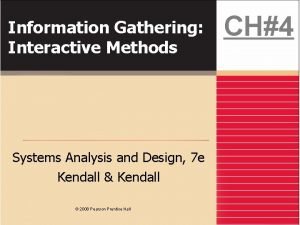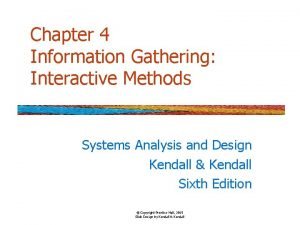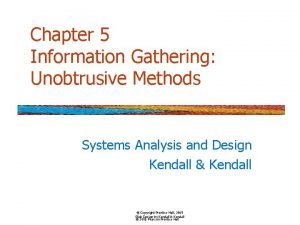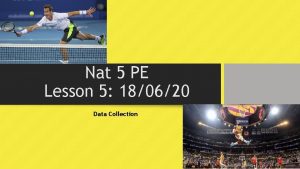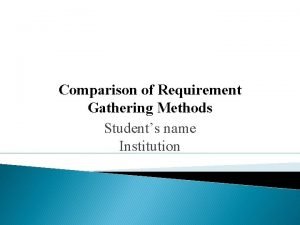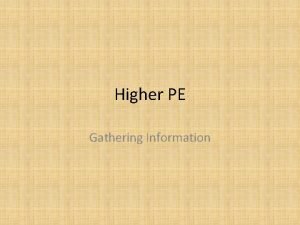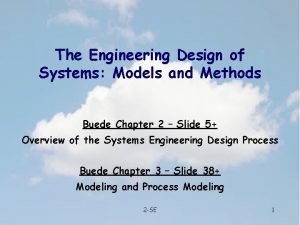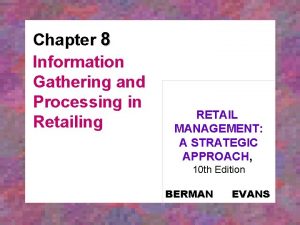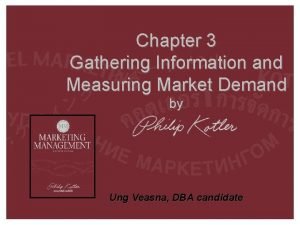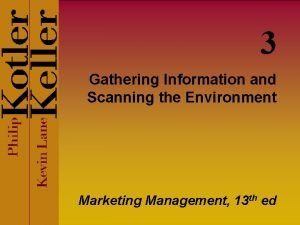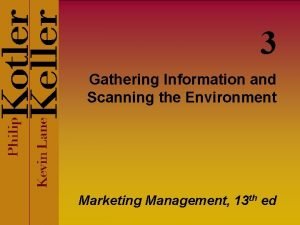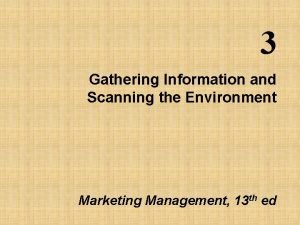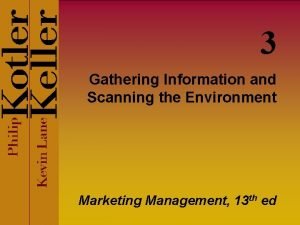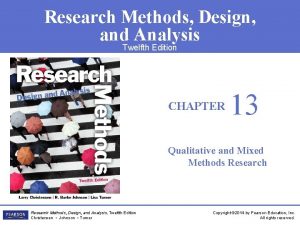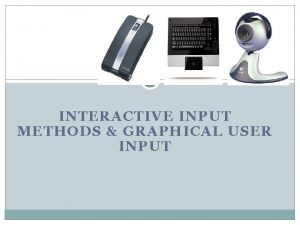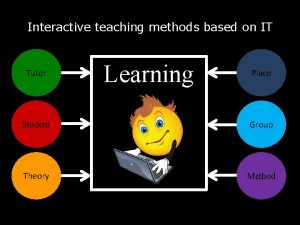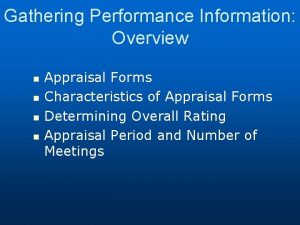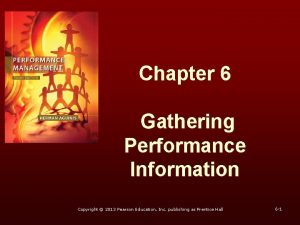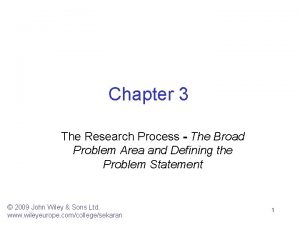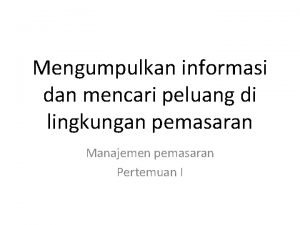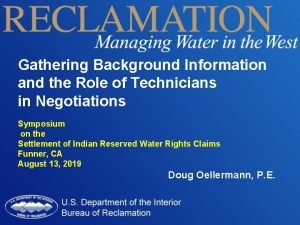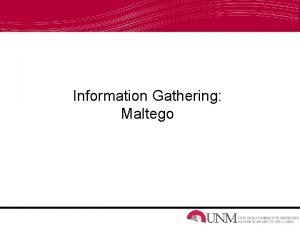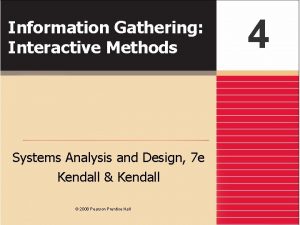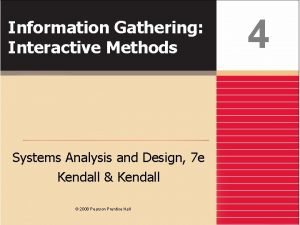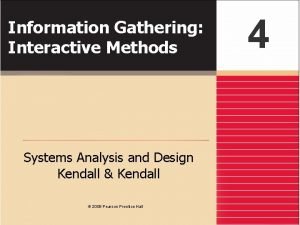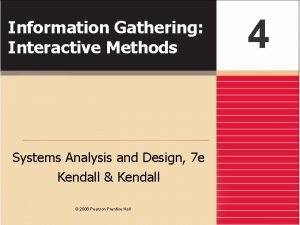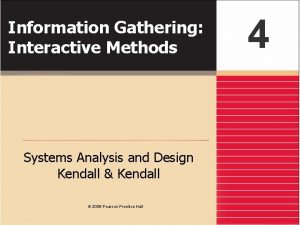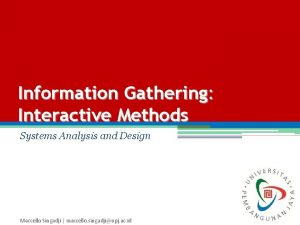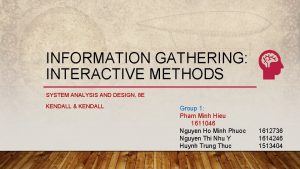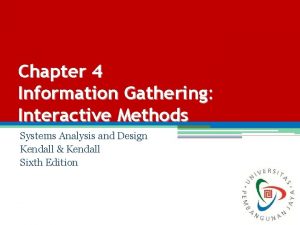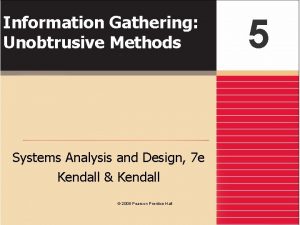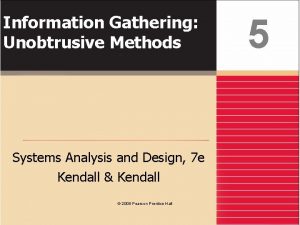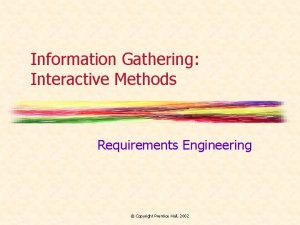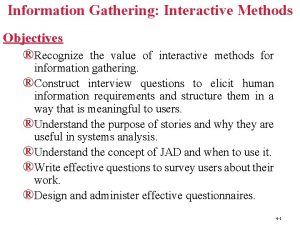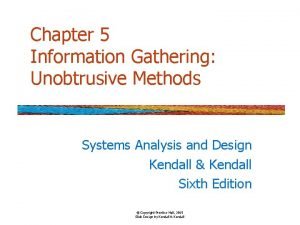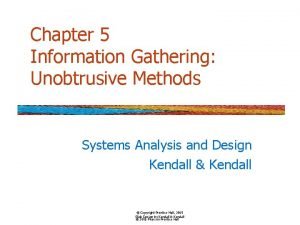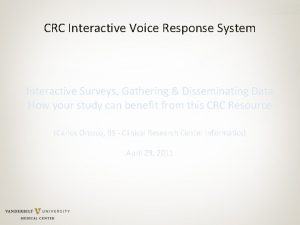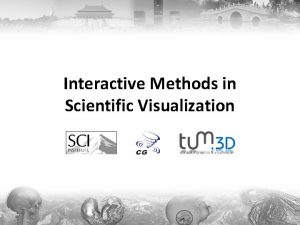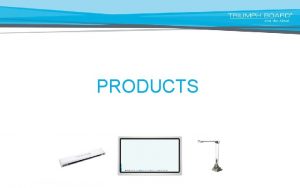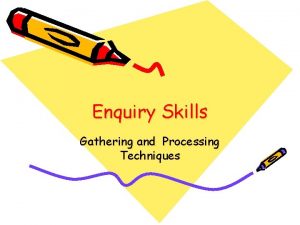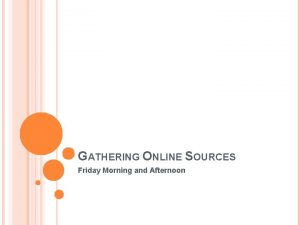Information Gathering Interactive Methods Systems Analysis and Design


























- Slides: 26

Information Gathering: Interactive Methods Systems Analysis and Design, 7 e Kendall & Kendall © 2008 Pearson Prentice Hall CH#4

Objectives • Recognize the value of interactive methods for information gathering • Construct interview questions to elicit human information requirements • Structure interviews in a way that is meaningful to users • Understand the concept of JAD and when to use it • Write effective questions to survey users about their work • Design and administer effective questionnaires Kendall & Kendall 4 -2

Interactive Methods to Elicit Human Information Requirements • Interviewing • Joint application design (JAD) • questionnaires Kendall & Kendall 4 -3

Major Topics • Interviewing • Interview preparation • Question types • Arranging Questions • The interview report • Joint Application Design (JAD) • Involvement • location • Questionnaires • Writing questions • Using Scales • Design • Administering Kendall & Kendall 4 -4

Interviewing • Interviewing is an important method for collecting data on human and system information requirements • Interviews reveal information about: • Interviewee opinions • Interviewee feelings • Goals • Key HCI concerns Kendall & Kendall 4 -5

Interview Preparation • • • Reading background material Establishing interview objectives Deciding whom to interview Preparing the interviewee Deciding on question types and structure Kendall & Kendall 4 -6

Question Types • Open-ended • Closed Kendall & Kendall 4 -7

Open-Ended Questions • Open-ended interview questions allow interviewees to respond how they wish, and to what length they wish • Open-ended interview questions are appropriate when the analyst is interested in breadth and depth of reply Kendall & Kendall 4 -8

Advantages of Open-Ended Questions • Puts the interviewee at ease • Allows the interviewer to pick up on the interviewee's vocabulary • Provides richness of detail • Reveals avenues of further questioning that may have gone untapped Kendall & Kendall 4 -9

Advantages of Open-Ended Questions (Continued) • Provides more interest for the interviewee • Allows more spontaneity • Makes phrasing easier for the interviewer • Useful if the interviewer is unprepared Kendall & Kendall 4 -10

Disadvantages of Open-Ended Questions • May result in too much irrelevant detail • Possibly losing control of the interview • May take too much time for the amount of useful information gained • Potentially seeming that the interviewer is unprepared • Possibly giving the impression that the interviewer is on a "fishing expedition” Kendall & Kendall 4 -11

Closed Interview Questions • Closed interview questions limit the number of possible responses • Closed interview questions are appropriate for generating precise, reliable data that is easy to analyze • The methodology is efficient, and it requires little skill for interviewers to administer Kendall & Kendall 4 -12

Benefits of Closed Interview Questions • Saving interview time • Easily comparing interviews • Getting to the point • Keeping control of the interview • Covering a large area quickly • Getting to relevant data Kendall & Kendall 4 -13

Disadvantages of Closed Interview Questions • Boring for the interviewee • Failure to obtain rich detailing • Missing main ideas • Failing to build rapport between interviewer and interviewee Kendall & Kendall 4 -14

Figure 4. 5 Attributes of 0 penended and closed questions Kendall & Kendall 4 -15

Bipolar Questions • Bipolar questions are those that may be answered with a ‘yes’ or ‘no’ or ‘agree’ or ‘disagree’ • Bipolar questions should be used sparingly • A special kind of closed question Kendall & Kendall 4 -16

Probes • Probing questions elicit more detail about previous questions • The purpose of probing questions is: • To get more meaning • To clarify • To draw out and expand on the interviewee's point • May be either open-ended or closed Kendall & Kendall 4 -17

Arranging Questions • Pyramid • starting with closed questions and working toward open-ended questions • Funnel • starting with open-ended questions and working toward closed questions • Diamond • starting with closed, moving toward open-ended, and ending with closed questions Kendall & Kendall 4 -18

Pyramid Structure • Begins with very detailed, often closed questions • Expands by allowing open-ended questions and more generalized responses • Is useful if interviewees need to be warmed up to the topic or seem reluctant to address the topic Kendall & Kendall 4 -19

Figure 4. 7 Pyramid structure for interviewing goes from specific to general questions Kendall & Kendall 4 -20

Funnel Structure • Begins with generalized, open-ended questions • Concludes by narrowing the possible responses using closed questions • Provides an easy, non-threatening way to begin an interview • Is useful when the interviewee feels emotionally about the topic Kendall & Kendall 4 -21

Figure 4. 8 Funnel structure for interviewing begins with broad questions then funnels to specific questions Kendall & Kendall 4 -22

Diamond Structure • A diamond-shaped structure begins in a very specific way • Then more general issues are examined • Concludes with specific questions • Combines the strength of both the pyramid and funnel structures • Takes longer than the other structures Kendall & Kendall 4 -23

Figure 4. 9 Diamond-shaped structure for interviewing combines the pyramid and funnel structures Kendall & Kendall 4 -24

Closing the Interview • Always ask “Is there anything else that you would like to add? ” • Summarize and provide feedback on your impressions • Ask whom you should talk with next • Set up any future appointments • Thank them for their time and shake hands Kendall & Kendall 4 -25

Interview Report • Write as soon as possible after the interview • Provide an initial summary, then more detail • Review the report with the respondent Kendall & Kendall 4 -26
 Information gathering in system analysis and design
Information gathering in system analysis and design Information gathering: interactive methods
Information gathering: interactive methods Unobtrusive methods of information gathering
Unobtrusive methods of information gathering What is fact analysis
What is fact analysis Methods of gathering data national 5 pe
Methods of gathering data national 5 pe Requirements gathering techniques agile
Requirements gathering techniques agile Cycle of analysis higher pe
Cycle of analysis higher pe The engineering design of systems: models and methods
The engineering design of systems: models and methods Information gathering and processing in retailing
Information gathering and processing in retailing Gathering information and measuring market demand
Gathering information and measuring market demand Forecasting and demand measurement in marketing
Forecasting and demand measurement in marketing Gathering information and scanning the environment
Gathering information and scanning the environment Gathering information and scanning the environment
Gathering information and scanning the environment Gathering information and scanning the environment
Gathering information and scanning the environment Gathering information and scanning the environment
Gathering information and scanning the environment Data input methods in system analysis and design
Data input methods in system analysis and design Research methods design and analysis
Research methods design and analysis What are interactive input methods
What are interactive input methods Interactive teaching methods
Interactive teaching methods 9 major components of appraisal forms
9 major components of appraisal forms Gathering performance information
Gathering performance information What is broad problem area in research
What is broad problem area in research 1 mencari atau mengumpulkan informasi
1 mencari atau mengumpulkan informasi Gathering activity
Gathering activity Gathering background information
Gathering background information Gathering background information
Gathering background information Maltego versions
Maltego versions
